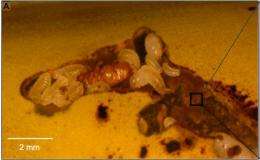October 4, 2011 report
Ambrosia beetles have highly socialized systems

(PhysOrg.com) -- Ambrosia beetles have long eluded scientists when it comes to being able to study their natural social structure. These beetles live deep within the solid wood of trees and when you disturb their natural nest, the beetles disappear.
However, researchers led by Peter Biedermann from the University of Bern have developed an alternative glass observation tube similar to the ambrosia beetles natural environment that they can use to observe natural behavior and their results have been published in this month’s Proceedings of the National Academy of Sciences.
In observing these beetles in their natural environment, the researchers discovered that the ambrosia beetles live in a highly socialized system. The adult females work to protect the colony and make sure the fungus gardens they rely on for food are tended to. The adult males spend most of their time grooming and mating with females.
The young beetles are put to work too. The Ambrosia beetle larvae are put to work cleaning and digging to expand the nest area.
The researchers compare these beetles to the other highly socialized insects such as wasps and ants.
However, there research left them with an unanswered question that Beidermann hopes to answer with continued study. From what they determined, the beetle larvae seem to hinder the growth of mold. Beidermann plans to study whether they use a type of bacteria to produce antibiotics similar to that of the leaf-cutter ants or if they produce some sort of secretion that accomplishes it on its own.
More information: Larval helpers and age polyethism in ambrosia beetles, PNAS, Published online before print October 3, 2011, doi:10.1073/pnas.1107758108
Abstract
Division of labor among the workers of insect societies is a conspicuous feature of their biology. Social tasks are commonly shared among age groups but not between larvae and adults with completely different morphologies, as in bees, wasps, ants, and beetles (i.e., Holometabola). A unique yet hardly studied holometabolous group of insects is the ambrosia beetles. Along with one tribe of ants and one subfamily of termites, wood-dwelling ambrosia beetles are the only insect lineage culturing fungi, a trait predicted to favor cooperation and division of labor. Their sociality has not been fully demonstrated, because behavioral observations have been missing. Here we present behavioral data and experiments from within nests of an ambrosia beetle, Xyleborinus saxesenii. Larval and adult offspring of a single foundress cooperate in brood care, gallery maintenance, and fungus gardening, showing a clear division of labor between larval and adult colony members. Larvae enlarge the gallery and participate in brood care and gallery hygiene. The cooperative effort of adult females in the colony and the timing of their dispersal depend on the number of sibling recipients (larvae and pupae), on the presence of the mother, and on the number of adult workers. This suggests that altruistic help is triggered by demands of brood dependent on care. Thus, ambrosia beetles are not only highly social but also show a special form of division of labor that is unique among holometabolous insects.
© 2011 PhysOrg.com
















